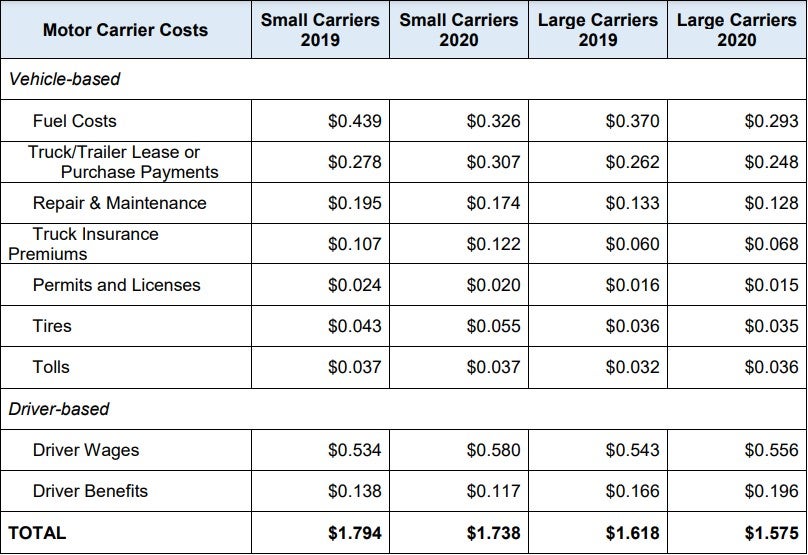After taking advantage of unexpected cost savings and profit windfalls caused by a historic pandemic, the trucking industry is already facing an uphill climb that could result in carriers closing shop.
“With costs increasing in diesel fuel, driver compensation and equipment purchase/leasing, carriers are likely to face higher operational costs in 2021 and 2022,” according to the to the latest analysis on trucking expenses released Tuesday by the American Transportation Research Institute (ATRI).
“Ongoing shortages and supply chain issues will present new challenges to the industry. Meanwhile, rising traffic levels and the decline in average truck speed from 40.62 in 2020 to 40.24 mph in 2021 mark the gradual return of less desirable pre-pandemic conditions.”
ATRI’s latest analysis, based on marginal costs incurred in 2020, included data from 138,930 truck tractors and 418,520 trailers of varying types, representing over 12 billion vehicle miles traveled. The study found that overall operational costs for small carriers fell 3.1% in 2020 compared with 2019 and dropped 2.7% for large carriers (see table).
Carriers were able to benefit from unusually low fuel costs and reduced highway traffic – presumably leading to lower congestion-related expenses – to offset higher expenses in other areas, according to ATRI.

Source: ATRI
The report also revealed greater cost differentials between fleet sizes and fleet sectors that ATRI had found in the past. For example, fleets with five to 100 power units were unable to take as much advantage of economies of scale in repair and maintenance costs relative to both larger carriers and smaller owner-operators.
In addition, while fleets with fewer than five power units typically have less purchasing power, they offset this by spending less on insurance premiums and repair and maintenance than fleets with five to 100 power units.
“Small fleets in general also benefited from an unusually strong spot market as demand exceeded larger fleets’ capacity,” according to the report. With regard to driver compensation costs, “carriers pursued two distinct strategies for navigating a competitive labor market: Small fleets offered comparatively higher wages while large fleets offered comparatively higher benefits.”
Highlights from the report include:
- Fuel costs dropped 7.6 cents from 38.4 cents in 2019 to 30.8 cents per mile in 2020, “a critical source of lower costs as carriers expended more on other cost centers,” ATRI noted.
- Wages increased while benefit costs per mile decreased; average compensation was slightly lower than 2019 but represented a greater share of overall marginal costs.
- Truck and trailer lease or purchase payments increased to an all-time high of 27.1 cents per mile – over 40% higher than 10 years ago, while repair and maintenance costs decreased for the first time in three years.
- Insurance premiums reached an all-time high cost of 8.7 cents per mile.
Despite higher costs for carriers on the immediate horizon, ATRI found reasons to be optimistic. For example, carriers will have opportunities to increase net revenues in 2021 and 2022 as capacity-related pricing rates exceed cost rates, the group stated. “After summer declines, truck tonnage increased in August and September of 2021. Spot rates and contract rates have continued to climb steadily throughout 2021 across all sectors.”
Also, industry research suggests that consumer spending on services will continue to recover over Q421 and in 2022 and consumer spending on goods will remain high, ATRI noted.
But Ignacio Araya, owner of Aora Cargo, an 11-unit long-haul trucking company based in Utah, is already feeling the effects of inflation and does not anticipate that changing soon.
“Business is getting increasingly difficult,” Araya told FreightWaves. “We’re paying over $4 a gallon in some states we operate, where last year it was $2. Within months I’ve seen inflation in equipment prices go through the roof.”
Araya purchased a used Freightliner Cascadia three months ago for $42,000. Three weeks ago, an identical truck jumped to $55,000 – a 30% price bump. “Used trailers are crazy expensive now too,” he said.
“I think we’re seeing the end of a cycle where the driver shortage, fuel, inflated equipment prices and everything else that has to do with keeping up the fleet are going to start forcing a lot of small companies out of business.”








Anymouse
Smaller carriers have the disadvantage of higher costs per mile, usually because of the greedy Idiots like Scott Shriner of Weston Transportation who hired a mentally challenged individual who killed a woman and her twin daughters in Indianapolis. Insurance companies run from companies run by incompetent fools.
Johanna Müller
I am Earning $81,100 so Far this year working 0nline and I am a full time college student and just working for 3 to 4 hours a day I’ve made such great m0ney.I am Genuinely thankful to and my administrator, It’s’ really user friendly and I’m just so happY that I found out about this
HERE………….>> http://www.EarnApp3.com